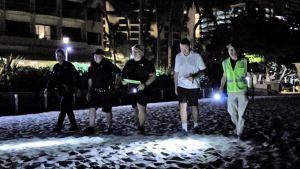UH is featured in this Waikīkī Business Improvement District Aloha Ambassador Documentary. UH‘s section begins at 6’33”.
The University of Hawaiʻi at Mānoa’s Department of Urban and Regional Planning has been a critical partner in the Waikīkī Business Improvement District (WBID) since its inception in 2000. For over two decades, faculty and students have provided support through data collection, analysis and research that helps shape the district’s development.

Professor Karl Kim, who has been involved since the beginning, initially contributed by mapping the area and developing financing scenarios based on various assessment calculations. Today, students gain real-world experience by tackling urban challenges alongside community professionals.
“It’s been largely a data-driven exercise that data and information can be used to improve the planning, design, management and operations of WBID,” Kim said. “Part of it is how do we get it right? How do we improve it? How do we not just sustain things as they are but how do we make things better? That’s what has been special and important about this partnership between WBID and the University of Hawaiʻi.”
Their work spans a wide range of issues affecting Waikīkī, from homelessness and design standards to transportation planning and disaster recovery. They have also done studies on evacuation planning and disaster debris management following hurricane or tsunami hazards. Students have conducted benchmarking reports on cleanliness, landscaping, and urban design, while also studying unique aspects of the district, such as street performers and holiday lighting.
This collaboration offers students practical experience in urban planning and design while connecting them with local professionals. They work with architects, engineers, and planners to develop and test solutions to a wide range of problems. Their efforts contribute directly to improving the quality of life and environment in one of Hawaiʻi‘s most iconic destinations. They are focused on sustainability and community resilience.
Real-world experiences

Dave Marasco, a UH Mānoa doctoral student in urban and regional planning and graduate assistant at the National Disaster Preparedness Training Center (NDPTC), worked as a homeless count coordinator.
“When we go out to do our semi-annual homeless counts, we identify homeless individuals by gender and age whenever possible, and then we record their respective locations on a map of Waikīkī,” Marasco said. “During these counts we have witnessed a variety of behaviors and conditions that clearly reinforce what a monumental struggle being homeless is.”
Jaeho Choi earned a doctor of architecture degree from UH Mānoa’s School of Architecture and a master’s degree in urban and regional planning. Choi works at NDPTC as an urban design and machine learning specialist.
“My role in the WBID project involved conducting an asset mapping pilot using advanced tools like total station and GIS,” Choi said. “This project aimed to resolve challenges faced during the previous 2008 inventory, including improving spatial analysis and enabling more efficient updates of asset data over time.”
The research supports urban design and planning to make Waikīkī more clean, green, beautiful and safe.
The partnership between the university and WBID exemplifies how academic institutions can play a vital role in community development, providing fresh perspectives and research-driven solutions to real-world problems.
The Department of Urban and Regional Planning is housed in UH Mānoa’s College of Social Sciences.

